Software Development Processes
Steven Zeil
Software Process Models
A software development process is a structured series of activities that comprise the way in which an organization develops software projects.
1 The Waterfall Model
The Waterfall Model
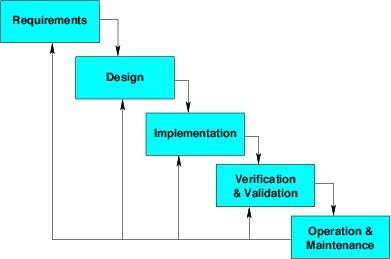 Perhaps the best-known and most widely used process model is the waterfall model.
Perhaps the best-known and most widely used process model is the waterfall model.
-
Some of the names of the phases in this process model are the same as the names of some of our workflows.
-
You need to rely on context to know whether “Design” is referring to a workflow or to a phase of the development process.
1.1 Requirements analysis
This phase establishes what the customer requires from a software system. The primary product of this phase is a requirements document.
What is a requirement?
May range from a high-level abstract statement of a service or of a system constraint to a detailed mathematical functional specification
-
This is inevitable as requirements may serve a dual function
-
May be the basis for a bid for a contract - therefore must be open to interpretation
-
May be the basis for the contract itself - therefore must be defined in detail
-
Both these statements may be called requirements
Sample Reqts Specification
1.1 The user should be provided with facilities to define the type of external files
1.2 Each external file type may have an associated tool which may be applied to the file.
1.3 Each external file type may be represented as a specification from the user’s display.
1.4 Facilities should be provided for the icon representing an external file type to be defined by the user.
1.5 When the user selects an icon representing an external file, the effect of that selection is to apply the tool associated with the type of the external file to the file represented by the selected icon.
The requirements document
-
The requirements document is the official statement of what is required of the system developers
-
Specify external system behaviour
-
Specify implementation constraints
-
Serve as reference tool for maintenance
-
It is not a design document. As far as possible, it should indicate WHAT the system should do rather than HOW it should do it
1.2 Design
This phase seeks to derive a solution which satisfies the software requirements. The primary product of this phase is design documentation.
Phases of design
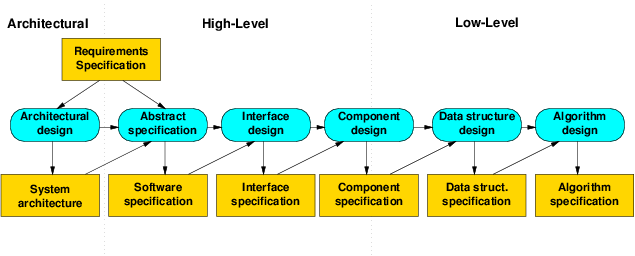
-
architectural design, the collection of decisions that need to be common to all components.
Examples of architectural design decisions would be
-
Will the system run on a single machine or be distributed over multiple CPUs?
-
Will outputs be stored in a file or in a database?
-
How will run-time errors be handled?
-
-
high-level design, dividing the system into components, and
-
low-level design (choosing the data structures and algorithms for a single component).
1.3 Implementation and unit testing
Writing the code – probably the most familiar activity.
The primary product of this phase is code – both application and test code.
1.4 Verification and Validation
Verification & Validation: assuring that a software system meets the users’ needs. The primary product of this phase is a test report.
The principle objectives are:
-
The discovery of defects in a system
-
The assessment of whether or not the system is usable in an operational situation.
V & V
 Although the waterfall model shows this as a separate phase near the end, we know that some forms of V&V occur much earlier.
Although the waterfall model shows this as a separate phase near the end, we know that some forms of V&V occur much earlier.
-
Requirements are validated in consultation with the customers.
-
Unit testing occurs during Implementation, etc.
So this phase of the waterfall model really describes system and acceptance testing.
1.5 Operation and maintenance
As requirements evolve and bug reports come in from the field, someone must
-
prioritize changes
-
make the changes
-
validate the changes
-
new test cases
-
validate that change does not break previously working code
-
regression testing
2 Iterative/Incremental Development
Iterative Development
Advantages:
- conducive to exploration of alternatives
-
e.g., throw-away prototyping
-
can lead to insight into poorly understood requirements (e.g., GUIs)
-
Disadvantages:
-
poor process visibility (e.g., are we on schedule?),
-
continual small drifts from the key architecture leading to poorly structured systems.
3 General OO Analysis & Design
General OO Analysis & Design
OOAD is largely viewed as a model-building activity. The primary models that we find are
-
domain model
-
analysis model
-
design model
and OOAD emphasizes a smooth evolution from one to the other.
3.1 Domain Models
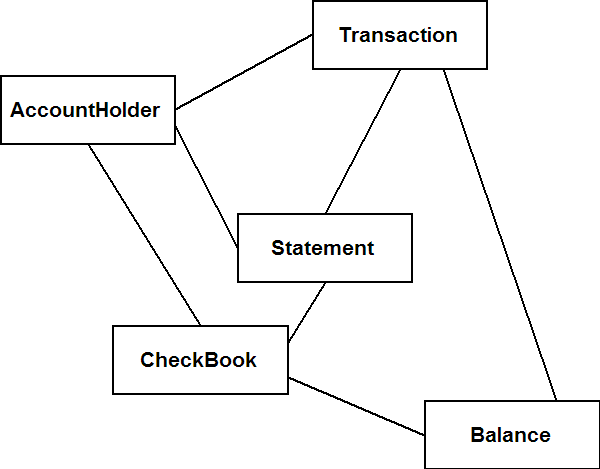 A domain model is a model of the application domain as it currently exists, before we began our new development project. The point of the domain model is to be sure the development team understands the world that the system will work in.
A domain model is a model of the application domain as it currently exists, before we began our new development project. The point of the domain model is to be sure the development team understands the world that the system will work in.
-
The domain model describes the world in terms of objects interacting with one another via messages.
-
Not every project needs a domain model (e.g., If the team has done several projects already in this application domain)
3.2 Analysis Models
An analysis model is a model of how the world will interact with the software system that we envision. As such, it is our statement of just what the system will do when it is working.
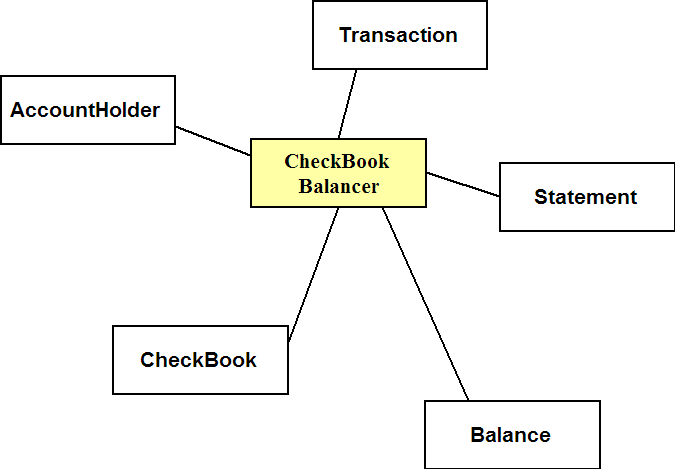 There is a real temptation to simply assume that the automated system will simply squat in the middle of the world, interacting with all the real world objects, sort of like this:
There is a real temptation to simply assume that the automated system will simply squat in the middle of the world, interacting with all the real world objects, sort of like this:
Or if you prefer,…
It’s Magic!
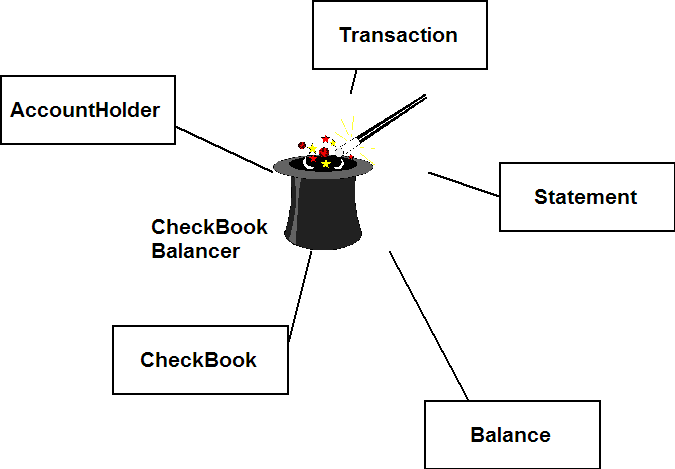 Poof! We have an analysis model!
Poof! We have an analysis model!
Not wrong, per se, but it’s certainly not helpful.
Such an approach is fundamentally at odds with the OO philosophy
-
We should look to the real world to suggest how to decompose our system.
-
In this case, we have not decomposed it at all – just wrapped it up into a single black box.
- All the hard decisions still need to be made.
Evolving the Analysis Model
What we really hope for is an evolution from our domain model to our analysis model. The OO philosophy tells us that the classes and interactions of our domain model …
 … should carry over into our analysis.
… should carry over into our analysis.
The Boundary
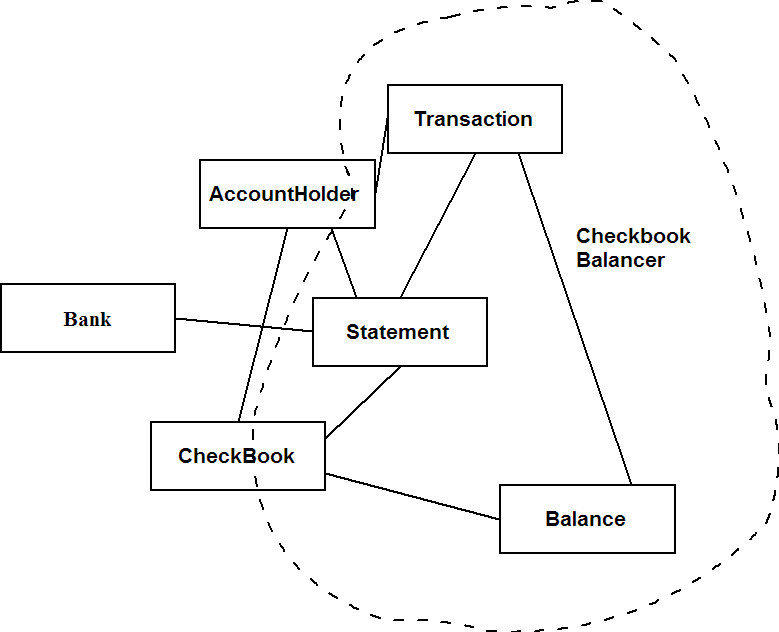 … establish a boundary that tells us which of these classes and behaviors will
… establish a boundary that tells us which of these classes and behaviors will
-
be automated
-
remain external
-
be a mixture of the two
The system, then, remains a collection of interacting objects rather than an unstructured black box.
3.3 Design Models
Design is concerned with how we can get the system to do the things the analysis model says it should do.
Designs are expressed via a design model,
Design Model: Agents
 A common step in OOD is to separate the classes that, in the analysis model, are partially implemented and partially external, into an purely external class representing the original, real-world objects, and an agent class that implements the automatable functions that will now be performed by the new system.
A common step in OOD is to separate the classes that, in the analysis model, are partially implemented and partially external, into an purely external class representing the original, real-world objects, and an agent class that implements the automatable functions that will now be performed by the new system.
Design Model: Agents (2)
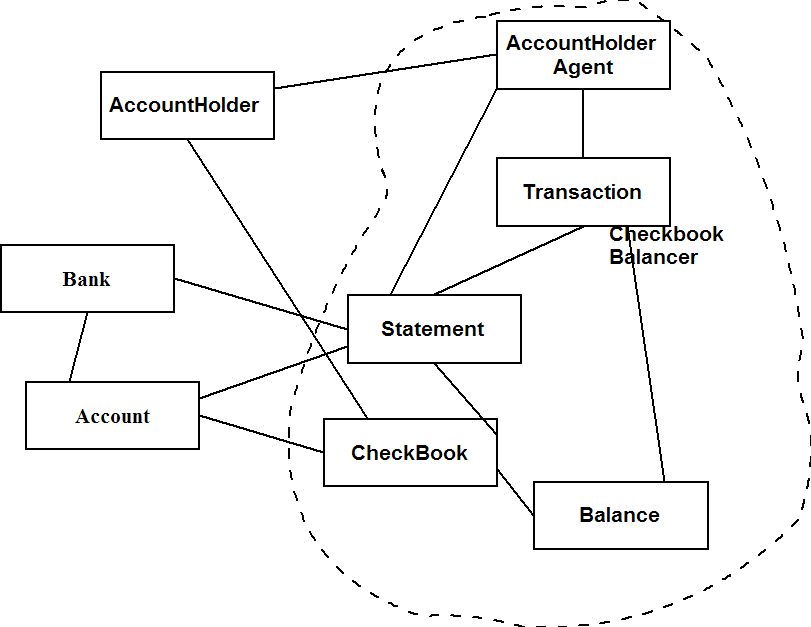 Here we have created an agent for AccountHolders
Here we have created an agent for AccountHolders
Design Model: Interfaces
 Then we can look closely at the lines (interactions) that cross the border from the outside world into the automated system.
Then we can look closely at the lines (interactions) that cross the border from the outside world into the automated system.
What do we call an interaction between an external entity and an internal automated entity?
Design Model: Interfaces
That’s the definition of an “interface”, and so
- each of those crossing points is a portion of the user interface (or an interface with other automated systems).
MVC
A common organizing principle for such interfaces is to distinguish between
-
viewers that portray the contents of automated classes and
-
controllers that accept external signals (e.g., mouse clicks, keyboard data) and interpret those signals as instructions to automated classes and to viewers.
-
Such viewers and controllers should be implemented as separate classes from the model classes that were derived from the analysis model.
MVC Example
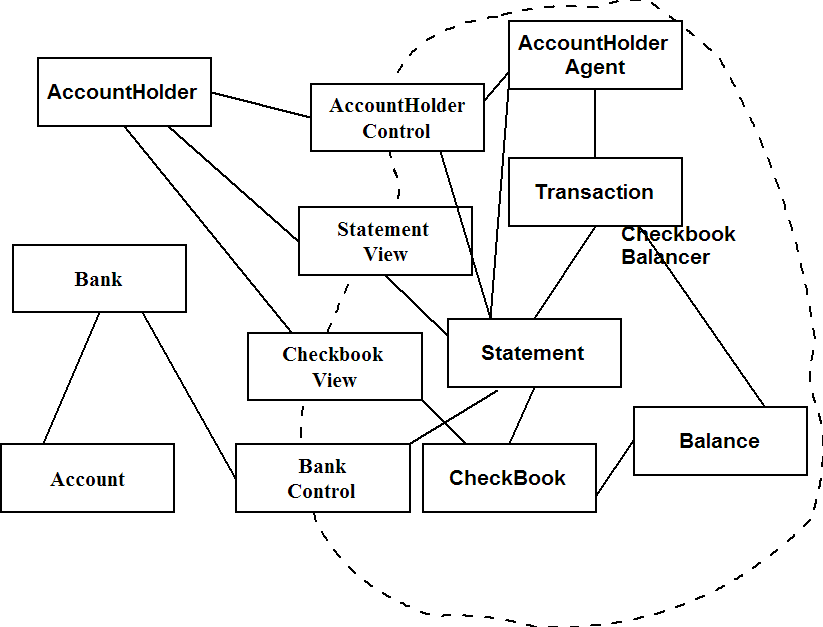 We then wind up with classes specifically devoted to managing the interface between the internal and external worlds.
We then wind up with classes specifically devoted to managing the interface between the internal and external worlds.
- This is the Model-View-Controller pattern:
Model-View-Controller
The MVC pattern establishes specific requirements so that GUI changes have minmal impact on the rest of the system.
-
The model classes must not depend on (make use of the interface of) the view and controlelr classes.
-
The view classes must not depend on the controller classes
4 The Unified Process Model
For larger projects, we may want something a bit more formal than the general OOA&D process.
The Unified Process was developed by Jacobsen, Booch, and Rumbaugh, who were already some of the biggest names in OOA&D before they decided to collaborate on a unified version of their previously distinctive approaches.

Unified Model Phases
-
Inception: initial concept
-
Elaboration: exploring requirements
-
Construction: building the software
-
Transition: final packaging
4.1 Inception
-
Pitching the project concept
-
Usually informal, low details.
-
“Perhaps we should build a … ”
4.2 Elaboration
-
Adding detail to our understanding of what the system should do.
-
Produces
-
Domain model
-
Analysis model
-
Requirements document
-
Release plan
-
Among these products, only the release plan is new.
4.2.1 Elaboration: Releases
In point of fact, each of the process phases may be divided into increments:

Such increments are most common in the elaboration and construction phases.
Each increment produces a release - some kind of product whose existence and/or acceptance by management shows that we are ready to move on.
A release represents the implementation of some part of the required functionality.
4.2.2 Elaboration: Release Plans
The release plan records decisions about
-
How many releases there will be
-
What functionality will be added with each release
-
When the releases will be made
-
Which releases are internal (i.e., only the development team sees them) and which are external
4.3 Construction
Perhaps the most familiar of the phases. This merges the waterfall activities of Design and Implementation.
-
Each construction increment adds new functionality
-
Documentation is constructed in addition to source code
-
Each increment must be separately tested
-
Each increment must be integrated and tested
4.4 Transition
Activities that can’t be done incrementally during construction, e.g.,
-
performance tuning
-
user training
5 The Unified Process and the Workflows
It should be noted again that the software development process model provides overall strategic guidance. The day-to-day “tactical” activity is still described by our four workflows.


